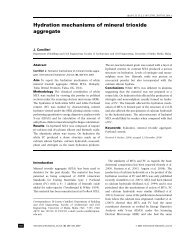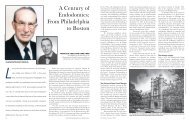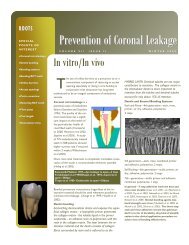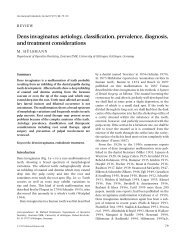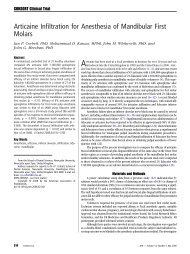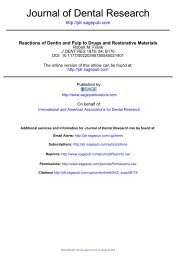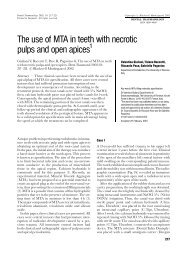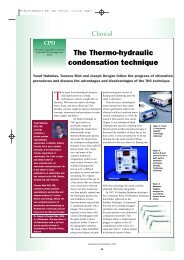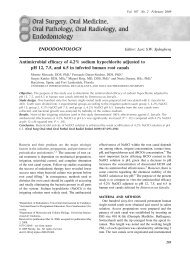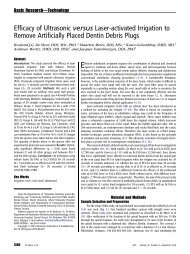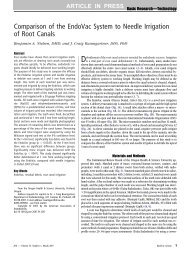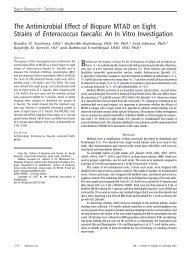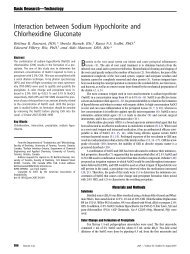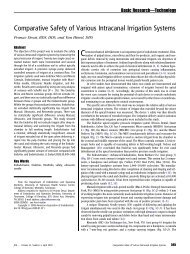BioPure™ MTAD™ Antibacterial Root Canal Cleanser Research
BioPure™ MTAD™ Antibacterial Root Canal Cleanser Research
BioPure™ MTAD™ Antibacterial Root Canal Cleanser Research
Create successful ePaper yourself
Turn your PDF publications into a flip-book with our unique Google optimized e-Paper software.
BioPure MTAD <br />
<strong>Antibacterial</strong> <strong>Root</strong> <strong>Canal</strong> <strong>Cleanser</strong><br />
<strong>Research</strong><br />
ANTIBACTERIAL<br />
1. Torabinejad M, Shabahang S, Aprecio RM, Kettering JD. The antimicrobial effect of<br />
MTAD: An in vitro investigation. J Endodon 2003; 29(6):400-3.<br />
• Summary:<br />
• The purpose of this investigation was to test the ability of a mixture of a<br />
tetracycline isomer, an acid and detergent (MTAD) to kill<br />
Enterococcus faecalis and compare its efficacy to that of NaOCl and<br />
ethylene diamine tetraacetic acid (EDTA). The zones of inhibition and<br />
minimum inhibitory concentrations were measured for these solutions.<br />
• Conclusion- Although EDTA demonstrated no antibacterial effects<br />
against E. faecalis, NaOCl and MTAD proved to be antibacterial to<br />
varying degrees. NaOCl continued to exert its efficacy up to 32x<br />
dilutions. On the other hand, MTAD was effective in killing E.<br />
faecalis up to 200x dilutions. Furthermore, although a 2 and 5 minute<br />
exposure of E. faecalis to undiluted of 1:2 dilution of NaOCl did not<br />
result in total killing of bacteria, exposure of the same bacterial species<br />
to undiluted or 1:2 diluted MTAD resulted in a completely negative<br />
culture after 2 and 5 minutes of exposure.<br />
• Based on the results of this and previous investigations, it seems that<br />
MTAD has the ability to remove most of the smear layer and it<br />
posseses superior bacterial activity compared with NaOCl or EDTA<br />
when tested against E. faecalis.<br />
• These results are significant because they demonstrate the efficacy of an<br />
irrigant to remove most of the smear layer and kill a bacterial strain<br />
that has been shown to be resistant to many commonly used intracanal<br />
irrigants and dressings.<br />
2. Shabahang S, Manouchehr P, Torabinejad M. In Vitro antimicrobial efficacy of<br />
MTAD and NaOCI. J Endodon 2003; 29(7):450-2.<br />
• Summary:<br />
• The purpose of this study was to compare the ability of MTAD with<br />
that of NaOCl to disinfect human root canals that had been<br />
contaminated with whole saliva.<br />
• Conclusion: The results of the investigation confirmed previous<br />
findings demonstrating almost 40% of the root canals remain infected<br />
using NaOCl and the superior antimicrobial activity of MTAD when<br />
compared with 5.25% NaOCl. An important finding in the study was<br />
the ability of MTAD to exert its antimicrobial effect during a brief<br />
time. This property is desirable in clinical practice where the root canal<br />
irrigants may be in contact with certain areas of the RCS for a short
time. Furthermore, this disinfecting property obviates the need for<br />
placement of an intracanal dressing necessitating multiple visits.<br />
3. Shabahang S, Torabinejad, M. Effect of MTAD on Enterococcus faecaliscontaminated<br />
root canals of extracted human teeth. J Endodon 2003; 29(9):576-9.<br />
• Summary:<br />
• The purpose of this investigation was to compare the antimicrobial<br />
effect of MTAD (a mixture of tetracycline isomer, an acid, and a<br />
detergent) with that of NaOCl (with and without EDTA) as a final<br />
irrigant on E. faecalis.<br />
• Conclusion: The results from these samples in the positive control<br />
showed that, debridement of root canals using distilled water, is unable<br />
to sterilize the root canal system.<br />
• The five samples in the negative control groups, which were exposed to<br />
the identical microbiological steps as the teeth in the experimental<br />
groups, demonstrated that the contamination did not occur during the<br />
culturing procedures. Absence of growth on the BHI plates using<br />
dentin shavings from this group confirmed that contamination did not<br />
occur during the preparation of the shavings.<br />
• The ineffectiveness of NaOCl to consistently disinfect root canals in<br />
this study is in agreement with results from previous investigations.<br />
This finding is especially true with E. faecalis, which is a bacterium<br />
that is known to resist the antibacterial effects of certain root canal<br />
medicaments.<br />
• Although the presence of the smear layer prevents penetration of<br />
antibacterial agents into the dentinal tubules, study results showed that<br />
removal of the smear layer with a one –minute rinse of 17% EDTA did<br />
not enhance the antimicrobial effects of NaOCl. The lack of increased<br />
antimicrobial efficacy may be due to the inability of NaOCl to remove<br />
the smear layer, its inability to penetrate into the dentinal tubules once<br />
the smear layer has been removed, or its ineffectiveness at killing E.<br />
faecalis. Findings also showed that removal of smear layer with a<br />
chelating solution (EDTA) that has little or no antibacterial effect,<br />
does not enhance the antibacterial effect of NaOCl.<br />
• Fisher’s exact test showed that the combination of 1.3% NaOCl as a<br />
root canal irrigant and MTAD as a final rinse was significantly more<br />
effective than the other regimens. The X 2 test showed no difference<br />
between other regimens.<br />
• On the basis of these results, it appears that MTAD is an effective final<br />
rinse for eradication of E. faecalis from extracted human teeth.<br />
4. University of Helsinki, Finland: E. faecalis culture results in teeth:<br />
Siren E, Pedruso E, Haapasalo M. In Vitro disinfection by MTAD, sodium<br />
hypochlorite and EDTA of dentin blocks infected by Enterococcus faecalis.<br />
• Summary:
• Freshly extracted human premolar, canine and maxillary incisor teeth<br />
were incubated in 0.5% NaOCl overnight for surface disinfection.<br />
• For infection, the test blocks were stored in each test tube with 5 ml of<br />
tryptone soya broth at 37° C with E. faecalis strain ATCC 29212<br />
bacteria. The broth was changed at every 2 to 3 days and the<br />
incubation continued for 2 weeks.<br />
• The irrigating solutions listed (below) were tested for their antibacterial<br />
effect against E. faecalis. EDTA was mixed with water into a 17%<br />
solution and the pH was adjusted to 7.0 by 1N NaOH. NaOCl was<br />
diluted from a 5% stock solution obtained by prescription from the<br />
pharmacist. All solutions were freshly prepared before the<br />
experiments.<br />
a. MTAD (BioPure, 100% solution) 10 min<br />
b. NaOCl 1.3% + MTAD (5 + 5 min)<br />
c. EDTA 17 % + NaOCl 1.3% (5 + 5 min)<br />
d. Sterile water (control) (10 min)<br />
e. MTAD 60 min<br />
f. NaOCl 1.3% + MTAD (5 + 55 min)<br />
• Bacterial killing was tested by removing sequential 100 micrometer<br />
thick layers of dentine with a sterile bur, starting from the main canal<br />
towards the periphery of the dentin block. Samples were taken to the<br />
depth of 450 micrometers and cultured immediately on culture media<br />
and checked for growth at 24 and 48 hours.<br />
• The average number of bacteria per sample in the first zone was<br />
20,266 ± 31,390 (mean ± SD) for sterile water. For the BioPure<br />
MTAD treatment for 10 minutes (without NaOCl), the average number<br />
of cells in the first zone was greatly reduced as compared to the<br />
control, the average being less than 1 % of the control values, 108 ±<br />
135 per sample. With E. faecalis A197A weak growth was detected in<br />
only one sample in the MTAD 10 min group (Group 1) using the<br />
tryptone soya broth culture (non-quantitative test). No growth was<br />
detected in the samples taken from the other groups.<br />
Summary of E. faecalis culture results in teeth: Both research groups (Loma Linda<br />
(surface disinfection) and the University of Helsinki, Finland (dentin block disinfection))<br />
determined that E. faecalis (2 strains) is eliminated in teeth/dentine by following the<br />
clinical protocol using BioPure MTAD cleanser with 1.3% NaOCl.
5. University of Oslo, Norway : <strong>Antibacterial</strong> Studies<br />
Portenier I, Waltimo T, Orstavik D, Haapasalo M. Killing of Enterococcus faecalis by<br />
MTAD, chlorhexidine digluconate and a combination of chlorhexidine diglugonate<br />
and cetrimide in the presence and absence of potential inhibitors.<br />
• Summary:<br />
• A study is underway at the University of Oslo in Norway to evaluate the<br />
killing of E. faecalis with various intra-canal rinses. In their tests, two<br />
medicaments are being tested:<br />
a. Bio-Pure MTAD <strong>Root</strong> <strong>Canal</strong> cleanser<br />
(DENTSPLY Tulsa Dental, Tulsa, USA), and<br />
b. chlorhexidine digluconate (Sigma Chemicals<br />
Co., St. Louis, MO, USA).<br />
• Their ability to kill E. faecalis is being tested in the presence of dentin<br />
or bovine serum albumin and at various dilutions. Two strains of E.<br />
faecalis bacteria are being used, to illustrate the variability of the<br />
organism:<br />
a. strain A197A, isolated from a persistent apical<br />
periodontitis, and<br />
b. strain VP3-80, isolated from a previously rootfilled<br />
tooth with chronic apical periodontitis.<br />
• Both strains of E. faecalis bacteria were reduced within seconds by<br />
both 100% BioPure MTAD and 0.2% chlorhexidine. After 5 minutes<br />
of treatment, no viable cells of strain E. faecalis A197A were detected.<br />
The VP3-80 strain of E. faecalis was slightly more resistant to BioPure<br />
MTAD and chlorhexidine solutions. Diluting the BioPure MTAD<br />
cleanser to 10% of its original concentration reduced the speed of<br />
killing, but the bacteria were killed within 20 minutes for one strain<br />
and 60 minutes for the other. Because the doxycycline binds to dentin,<br />
the drug and its effects may be available to the body for more than the<br />
5-minute treatment. This means that the BioPure MTAD cleanser may<br />
continue to kill bacteria after the cleanser liquid is removed from the<br />
canal. However, extreme dilution (to 1%) fails to eliminate bacteria<br />
during a 1-hour incubation period.<br />
• Another dilution experiment was conducted with inhibitors: dentin &<br />
bovine serum albumin (to simulate human collagen). BioPure MTAD<br />
and 0.2% chlorhexidine were affected by dentin and bovine serum<br />
albumin. Both dilution and the inhibitors delayed the killing of E.<br />
faecalis. It took up to 24 hours to kill the bacteria with the addition of<br />
dentin powder. The bovine serum albumin was less inhibitory and<br />
virtually all bacteria were killed in this test with dilute solutions after 1<br />
hour.
6. NAMSA (North American Science Associates): Zone of Inhibition and Minimum<br />
Inhibitory Concentration Testing<br />
• Summary:<br />
• Zone of inhibition tests were performed by NAMSA with BioPure<br />
MTAD solutions. The Kirby-Bauer zone of inhibition test method was<br />
used with 8 replicates with E. faecalis bacteria. These samples were<br />
inoculated at 37°C for 18 to 24 hours and 8 replicates were tested and<br />
the results were assessed as inhibitory or non-inhibitory by NAMSA.<br />
• The zone of inhibition tested was performed to determine that inhibition<br />
of growth occurred with fresh samples and aged samples. One sample<br />
had been aged for 6 months and second had been subjected to higher<br />
temperature and humidity (40°C/75% relative humidity for 15 weeks)<br />
to simulate aging for 1 year at room temperature.<br />
• Minimum inhibitory concentration testing was also conducted by<br />
NAMSA.<br />
• The fresh, the aged and the accelerated testing samples all had<br />
inhibitory effects on the growth of E. faecalis bacteria. These<br />
diameters at NAMSA show inhibition of growth of E. faecalis<br />
bacteria. The zones of inhibition were roughly the same for all<br />
samples.<br />
• In their minimum inhibitory concentration tests, no growth of E.<br />
faecalis bacteria was observed up to a dilution of 1 in 2048, a higher<br />
effective dilution than measured by Loma Linda University. At<br />
NAMSA, E. faecalis was used with 1.2x10 5 colony forming units/ml.<br />
Independent Testing Summary: Three studies at independent locations have<br />
validated, using standard in vitro models, that E. faecalis bacteria is killed by BioPure<br />
MTAD root canal cleanser. All 3 sites confirm the killing of E. faecalis bacteria. The test<br />
results for zone of inhibition and minimum inhibitory concentration are similar in their<br />
results at the two sites using this technique. However, the strain of E. faecalis bacteria did<br />
affect the test results. Two strains were tested and the BioPure MTAD cleanser was<br />
effective against both. Aged samples (zone of inhibition tests) to date show no diminution<br />
of efficacy of kill. Dentin powder and bovine serum albumin slowed but did not eliminate<br />
the killing effect of BioPure MTAD cleanser. As with any medicament, dilution also<br />
affected its rate of bacterial killing.<br />
7. Beltz RE, Torabinejad M, Pouresmail M. Quantitative analysis of the solubilizing<br />
action of MTAD, sodium hypochlorite, and EDTA on bovine pulp and dentin J<br />
Endodon 2003; 29(5):334-7.<br />
• Summary :<br />
• The purpose of this study was to determine the amount of tissue loss<br />
after exposing bovine pulp and dentin to MTAD, three concentrations<br />
of NaOC, 17% EDTA and isotonic saline.
• Conclusion: The results showed that various concentrations of NaOCl<br />
removed organic components of the pulp and dentin effectively. As<br />
pulp solubilizers. 5.25% and 2.60% NaOCl were equal (>90%), and<br />
5.25% NaOCl was capable of dissolving virtually the entire organic<br />
component of dentin. EDTA was capable of solubilizing inorganic<br />
material in dentin and organic material in pulp and most likely in<br />
dentin. It dissolved >70% of the dentin and >51% of the pulp. The<br />
solubilizing effects of MTAD on pulp and dentin were somewhat to<br />
those of EDTA. The major difference between the actions of these<br />
solutions was a high binding affinity of doxycycline present in MTAD<br />
for the dentin.<br />
BIOCOMPATABILITY<br />
1. Zhang W, Torabinejad M, Li Y. Evaluation of cytotoxicity of MTAD using the<br />
MTT tetrazolium method. J Endodon 2003; 29(10):654-7.<br />
• Summary:<br />
• The purpose of this investigation was to test the cytotoxicity of MTAD<br />
compared with that of commonly used irrigants and medications.<br />
• Conclusion: Based on the test results, it seems that MTAD is less<br />
cytotoxic than eugenol, 3% H 2 O 2 , Ca(OH) 2 paste, 5.25% NaOCl,<br />
Peridex and EDTA. The results show MTAD is more cytotoxic than<br />
2.63%, 1.3% and 0.66% NaOCl.<br />
• With the ID 50 at 6750 µg/ml, it seems that the cytotoxicity of MTAD is<br />
minimal as evaluated by the MTT-tetrazolium method.<br />
2. Torabinejad, M, Shabahang, S, Bahjri, K. Effect of MTAD on Postoperative<br />
Discomfort: A Randomized Clinical Trial. J Endodon 2005; 31(3): 171-176.<br />
• Summary:<br />
• The purpose of this study was to compare levels of post-operative<br />
discomfort after cleaning and shaping of root canals using two<br />
protocols for removal of the smear layer.<br />
• Conclusion: No patient developed severe swelling, pain or other side<br />
effects necessitating removal from this study. Mild pain decreased<br />
gradually in both groups over the seven days.<br />
• A significant change was measured in the mean pain scores over time<br />
for both treatment groups (p0.05).
• No significant differences were observed when pre- and post-operative<br />
comparisons of several outcome variables were made.<br />
• BioPure MTAD antibacterial root canal cleanser solution did not cause<br />
discomfort in patients who had a final rinse for the removal of the<br />
smear layer.<br />
3. Mutagenicity Testing – Loma Linda University<br />
• Summary:<br />
• The 2 nd test for the mutagenic potential was conducted using the Ames<br />
Salmonella /Microsome protocol. In this test, the BioPure MTAD<br />
cleanser was compared to 5.25% sodium hypochlorite at 5 doses, using<br />
4 strains of cells. Pyrogen-free water was used as a solvent and as the<br />
negative control. The agar test medium and bacteria were incubated at<br />
37°C for 48 hours. S9 rat liver preparation was included to enhance the<br />
sensitivity of the test. The plates were examined for revertant colonies<br />
of bacteria, indicative of mutagenicity.<br />
• Conclusion: The mutagenic potentials of BioPure MTAD and sodium<br />
hypochlorite solutions were evaluated using the Ames test. No<br />
significant differences were noted between the negative (nonmutagenic)<br />
control and the BioPure MTAD or sodium hypochlorite<br />
solutions, with or without S9 rat liver cell microsomal activation.<br />
Therefore, the BioPure MTAD cleaner and sodium hypochlorite were<br />
not mutagenic.<br />
4. Machnick TK, Torabinejad M, Munoz CA, Shabahang S. Effect of MTAD on<br />
flexural strength and modulus of elasticity of dentin. J Endodon, 2003; 29 (11):747-50.<br />
• Summary<br />
• The purpose of this study was to evaluate the effect of MTAD on the<br />
flexural strength and modulus of dentin.<br />
• Conclusion: Based on the study results it seems that using the clinical<br />
protocol for MTAD causes no adverse effects on the physical<br />
properties of exposed dentin. The results of this in vitro study suggest<br />
that MTAD possesses most of the positive qualities of an ideal root<br />
canal irrigant.<br />
BOND STRENGTH<br />
1. Machnick TK, Torabinejad M, Munoz CA, Shabahang, S. Effect of MTAD on the<br />
bond strength to enamel and dentin. J Endodon 2003; 29(12):818-21.<br />
• Summary:<br />
• This study was conducted to compare the effect of MTAD ((a mixture<br />
of tetracycline isomer, an acid (citric acid), and a detergent (Tween<br />
80)) and a phosphoric acid on the bond strength to enamel using a<br />
conventional OptiBond Solo Plus dentin adhesive system.<br />
• Conclusion: According to these findings, it appears that teeth<br />
endodontically treated with MTAD protocol for clinical use (20
minutes 1.3% NaOCl/ 5 minutes with MTAD) may not need additional<br />
conditioning before the application of the dental adhesive.<br />
CORONAL LEAKAGE<br />
1. Park DS, Torabinejad M, Shabahang S. J Endod. 2004; 30(12):890-2. The Effect of<br />
MTAD on the coronal leakage of obturated root canals.<br />
• Summary<br />
• The effect of the BioPure MTAD antibacterial root canal cleanser was<br />
compared to that of other materials for preventing coronal leakage.<br />
The India ink penetration method was used with fifty non-carious,<br />
extracted, human, single-rooted teeth with closed apices.<br />
a. 5.25% NaOCl; no sealer, obturation with guttapercha<br />
(positive control),<br />
b. 5.25% NaOCl; AH plus sealer, obturation with<br />
gutta-percha, and sticky wax (negative control).<br />
c. 5.25% NaOCl; AH plus sealer, obturation with<br />
gutta-percha,<br />
d. 5.25% NaOCl, 5 ml of 17% EDTA for 5<br />
minutes, 5.25% NaOCl; AH plus sealer,<br />
obturation with gutta-percha and, or<br />
e. 1.3% NaOCl, 5 ml of BioPure MTAD for 5<br />
minutes; AH plus sealer, obturation with gutta<br />
percha.<br />
• In the first group (positive control), the dye penetrated the entire length<br />
of each tooth’s canal. No dye penetration was measured for the<br />
negative control- group 2. The “NaOCl only” group (#3) experienced<br />
more microleakage than did the group with BioPure MTAD cleanser<br />
and NaOCl (#5). Numerically, the EDTA group (#4) had more<br />
microleakage than the BioPure MTAD group (#5), but the difference<br />
was not statistically significant.<br />
DISCOLORATION<br />
1. Tetracycline binds to calcium in the hydroxylapatite crystals during the development<br />
stage of hardening or calcifying of teeth. This chelation of the tetracycline leads to<br />
permanent tooth discoloration in the permanent teeth as they develop, or in deciduous<br />
teeth. To avoid discoloration, tetracycline products, including BioPure MTAD cleanser,<br />
should NOT be taken by young children with developing teeth (
Chlorhexidine containing products do extrinsically stain teeth, but BioPure MTAD<br />
cleanser does not contain chlorhexidine.<br />
SMEAR LAYER REMOVAL<br />
1. Torabinejad M, Handysides R, Khademi, AA, Bakland LK. Clinical implications of<br />
the smear layer in endodontics. Oral Surg 2002; 94:658-66.<br />
• Summary:<br />
• The purpose of this article was to review current evidence regarding<br />
clinical implications of the smear layer in endodontics.<br />
2. Torabinejad M, Khademi AA, Babagoli J, Cho Y, Johnson WB, Bozhilov K, Kim J,<br />
Shabahang S. A new solution for the removal of the smear layer. J Endodon 2003;<br />
29:170-5.<br />
• Summary:<br />
• The purpose of this study was to evaluate the effectiveness of an<br />
irrigant solution, a mixture of a tetracycline isonomer, an acid, and a<br />
detergent (MTAD), to disinfect the dentin, remove the smear layer.<br />
Open the dentinal tubules and allow the antibacterial agents to<br />
penetrate the entire root canal system.<br />
• Conclusion: Based on the results of this study, it seems that MTAD is<br />
an effective solution for the removal of the smear layer when used as a<br />
final rinse. It does not significantly change the structure of the dentinal<br />
tubules when used in conjunction with NaOCl as a root canal irrigant.<br />
• The results demonstrated that MTAD is also less destructive to the tooth<br />
structure compared with EDTA when used as a final irrigant. Close<br />
examination of the appearance of the dentinal tubules showed higher<br />
amounts of erosion with EDTA. This study also showed no significant<br />
difference in the ability of distilled water and NaOCl to remove the<br />
smear layer from the surfaces of instrumented canals because both<br />
irrigants were ineffective.<br />
3. University of North Carolina: Smear Layer Removal/SEM’s<br />
• Summary:<br />
• Partial results are available from the University of North Carolina. The<br />
smear layer remained when either the distilled water or the 1.5%<br />
NaOCl rinse was used. BioPure MTAD and EDTA solutions were<br />
equally effective in smear layer removal, producing a clean dentin<br />
surface. No comparisons using the rating system for the areas of the<br />
root canals are yet available. However, the efficacy of BioPure MTAD<br />
cleanser in removing the smear layer is clear. Both EDTA solution and<br />
BioPure MTAD cleanser were effective in removing the smear layer.
4. Torabinejad M, Cho Y, Khademi AA, Bakland LK, Shabahang S. The effect of<br />
various concentrations of sodium hypochlorite on the ability of MTAD to remove the<br />
smear layer. J Endodon 2003(4); 29:233-9.<br />
• Summary:<br />
• The purpose of this study was to investigate the effectiveness of various<br />
concentrations of sodium hypochlorite (NaCCl) as an intracanal<br />
irrigant before the use of MTAD (a mixture of tetracycline isomer, an<br />
acid and a detergent) as a final rinse to remove the smear layer.<br />
• Conclusion: The results show that although MTAD removes most of the<br />
smear layer when used as an intracanal irrigant, some remnants of the<br />
organic component of the smear layer remain scattered on the surface<br />
of the root canal walls. The effectiveness of MTAD to completely<br />
remove the smear layer is enhanced when low concentrations of Na<br />
OCl are used as an intracanal irrigant before the use of MTAD as a<br />
final rinse. The regimen does not seem to significantly change the<br />
structure of dentinal tubules.



